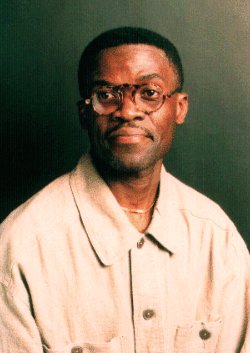
The exhibition has
the following touring agenda for 2002:
Elverum 14.1 - 8.2
Aamot
(Rena)11.2 - 15.3
Tynset 18.3 . 26.4
home.earthlink.net/
~dorothyhamm/index.html
sites.netscape.net/hammdorothy/
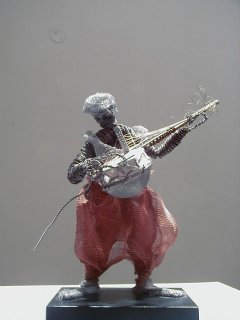
Augie
N´Keles
FORGOTTEN
HERITAGE - AN AFRICAN HISTORY
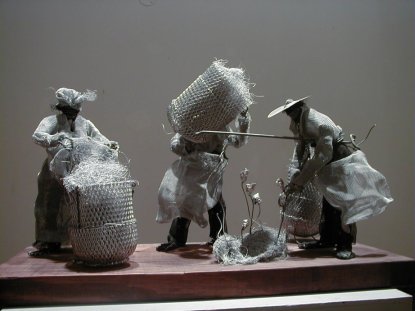
Augie N´Keles exhibition "Forgotten Heritage" has been touring Norway for a year and has been an immense success. Particularly as an integrated part of education in contemporary history.
If Congolese artist Augie N´Kele had not chosen to immigrate to the United States he might never have created Forgotten Heritage, his largest body of work and the work for which he is best known. If he had never experienced, the loneliness of being a stranger in a strange land, the challenge of adapting to unfamiliar customs, sounds, and foods...if he had never known the pain of coping with loss of loved ones left behind...he might not have felt the pain of his countrymen´s past enslavement so intensely that he was moved to try to portray it in sculpture.
N´Kele was born in Kisangani in what was then called the Belgian Congo (later Zaire). He grew up in Kinshasa. After completing courses at the Institute of Art in Kinshasa and Lumbumbashi (BFA, Emphasis Painting, 1979) he studied interior design at Notre Dame de la Sagesse in Brussels, Belgium (1980-82) before moving to the US in 1982.
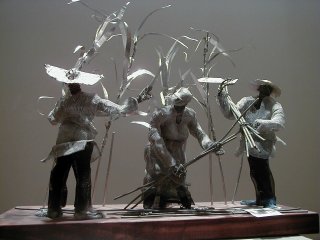
During his first years in America there was no time to pursue art as he struggled to get established and send for his wife and baby daughter. When he was lonely or homesick, as he often was, he pushed those feelings to the back of his mind. He learned the language, his fifth. (Others are French, Swahili, Lingala and Kikongo.) He worked as a dishwasher and busboy and other menial jobs, 16 hours a day most of the time. His lowest point after coming to America, perhaps the lowest point ever in his entire life, came when he received the message telling him his mother had died of injuries received in an automobile accident. The crushing loss of his beautiful, wise, and loving mother with whom he had always been especially close, slammed into him with terrible force. She was his greatest supporter, always encouraging him to develop his talents and follow his dreams. His pain was compounded by the awful fact that he was unable to even attend her funeral. He was denied the scant comfort and the closure that would have afforded.
For almost a decade N´Kele ignored his art. During his years as a student in Africa and Belgium he had made pocket money by sketching prominent people and offering the portraits to them for sale. He didn´t think of keeping copies. Except for a few sketches (on scraps of paper, backs of envelopes, even old receipts) that lay collecting dust in the back of his closet, there was little evidence to remind him that since he had been a child and first held a pencil in his hand he had had a God-given talent to draw. Some events in the 1990s made some more major changes in the young artist´s life. He enrolled in a sculpture class at a community college, the same college where he had taken English as a Second Language and some other courses through the years. He had not previously worked in a three dimensional format but quickly grew to love the feel of creating shapes with his hands.
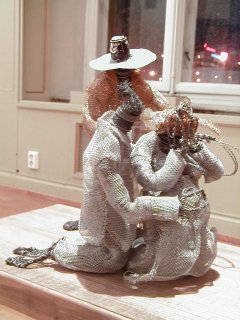
He experimented with wax, plaster and clay. Another turning point, came from a chance meeting with Robert Glen, the artist who created the Dallas area landmark sculpture, Mustangs of Las Colinas. Although they spoke only briefly, Glen´s words of encouragement energized the fledgling sculptor. Shortly after their meeting N´Kele began his Forgotten Heritage series. As N´Kele prepared to add plaster to the armature of what would be the first of many works, a camel caravan, he paused and looked at the wire base he had constructed and decided he liked it the way it was. The openness of the wire and aluminum mesh framework seemed to add to the honesty of the subject matter. The tall, slender, gentle natured man from Congo, had many things he wanted to say...as an artist...a man...an African...an American. Through sculpture he had found his voice. That he was now a different person was apparent in the new work he produced. No longer content to do portraits of celebrities and playful sketches of African life, his work was heavily influenced by African history. He drew from memories of his youth in Congo as well as events he had studied about in school and his own personal experiences learning to adapt to a world vastly different from the familiar.
His medium was made up of simple materials easily available from hardware stores: wire, aluminum mesh and found objects, which he wove, without benefit of solder or welding, into intricate narrative works. While he fulfilled his artist´s need to create, he hoped his work would also serve as a stimulus to increase interest in African history and culture. As fate would have it, the person most stimulated to learn more about the subject was the artist himself. Once begun, Forgotten Heritage seemed to take on a life of its own, becoming a dominant force in N´Kele´s life. When he was not creating new works, he was doing research. The two dozen works he first envisioned evolved into more than 200.
During the decade since its inception, Forgotten Heritage has been an ever-present part of all conscious thought. It is the sun, around which all his other thoughts revolve. Even when he isn´t producing new work, the project is never dormant. It may undergo different stages of gestation, but it remains very much a work in progress. "It´s a really big part of my life, a driving force," N´Kele says with obvious sincerity. I live with it. I go to bed with it. I wake up with it. It is like a part of my body. Only God can make me stop."
"Forgotten Heritage" is an on-going series of sculptures by contemporary Zairian artist Augie N´Kele. It portrays the 500-year-old shared history between Africa and the Americas from an African perspective. This work-in-progress now includes over 150 sculptures divided into four "chapters": starting with "Life In Africa", "Capture & Enslavement", "Life In The New World", and ending with "Civil Rights".
Called a "storyteller with his hands", sculptor Augie N´Kele has chronicled African and American life before, during and at the end of slavery.
A native of Zaire, N´Kele received his degree in painting in Belgium, then moved to the Dallas, Texas area, where he met and was heavily influenced by Robert Glen, the sculptor who created the mustang sculpture at Las Colinas. Using scrap metal, aluminum gutter mesh, copper wire, pipes and other found objects, N´Kele began to create a series of small pieces depicting the cultural life of Africa and the United States during the period of slave trading.
The series has evolved into an oeuvre of more than 150 works, beginning with scenes of village life in Africa, then moving on to scenes of slave trade in Africa and then the experiences of plantation life in the United States and the Caribbean Islands.
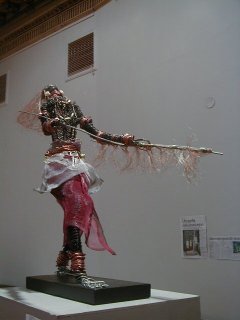
N´Kele emphasizes the importance of the African American to the economic growth of the United States during this period; a key work, Slavery II (1995), depicts richly-dressed plantation owners standing on a platform supported by slaves, symbolizing the owners´ dependence upon the African American workers for their wealth. A statue of the freedom fighter Harriet Tubman is accompanied by a text relating the story of her escape to freedom and her courage as she assisted others to escape by the Underground Railroad.
N´Kele is passionate about the need to recount this history for generations to come. Although many of the scenes associated with slavery are disturbing, they are a very real part of our history and represent the heritage of the African American; this is a story that must not be forgotten.
